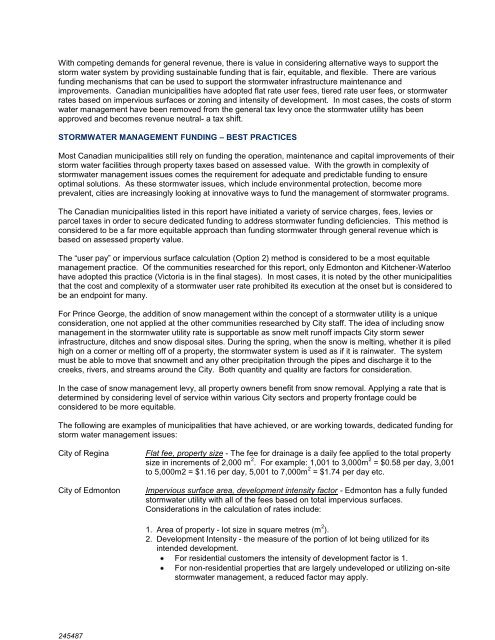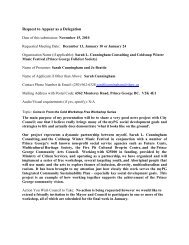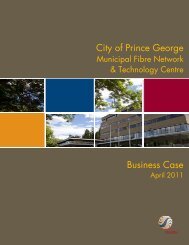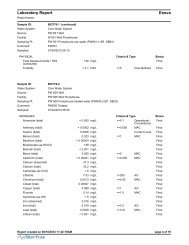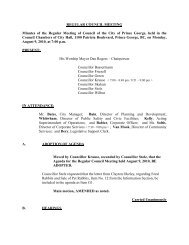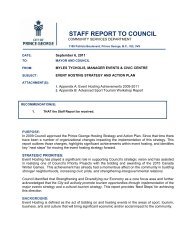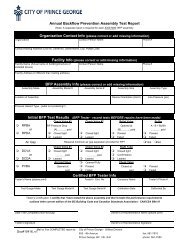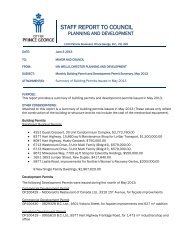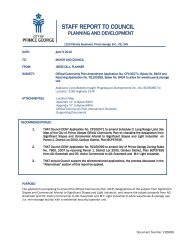Stormwater Management Funding Strategy - City of Prince George
Stormwater Management Funding Strategy - City of Prince George
Stormwater Management Funding Strategy - City of Prince George
Create successful ePaper yourself
Turn your PDF publications into a flip-book with our unique Google optimized e-Paper software.
245487With competing demands for general revenue, there is value in considering alternative ways to support thestorm water system by providing sustainable funding that is fair, equitable, and flexible. There are variousfunding mechanisms that can be used to support the stormwater infrastructure maintenance andimprovements. Canadian municipalities have adopted flat rate user fees, tiered rate user fees, or stormwaterrates based on impervious surfaces or zoning and intensity <strong>of</strong> development. In most cases, the costs <strong>of</strong> stormwater management have been removed from the general tax levy once the stormwater utility has beenapproved and becomes revenue neutral- a tax shift.STORMWATER MANAGEMENT FUNDING – BEST PRACTICESMost Canadian municipalities still rely on funding the operation, maintenance and capital improvements <strong>of</strong> theirstorm water facilities through property taxes based on assessed value. With the growth in complexity <strong>of</strong>stormwater management issues comes the requirement for adequate and predictable funding to ensureoptimal solutions. As these stormwater issues, which include environmental protection, become moreprevalent, cities are increasingly looking at innovative ways to fund the management <strong>of</strong> stormwater programs.The Canadian municipalities listed in this report have initiated a variety <strong>of</strong> service charges, fees, levies orparcel taxes in order to secure dedicated funding to address stormwater funding deficiencies. This method isconsidered to be a far more equitable approach than funding stormwater through general revenue which isbased on assessed property value.The “user pay” or impervious surface calculation (Option 2) method is considered to be a most equitablemanagement practice. Of the communities researched for this report, only Edmonton and Kitchener-Waterloohave adopted this practice (Victoria is in the final stages). In most cases, it is noted by the other municipalitiesthat the cost and complexity <strong>of</strong> a stormwater user rate prohibited its execution at the onset but is considered tobe an endpoint for many.For <strong>Prince</strong> <strong>George</strong>, the addition <strong>of</strong> snow management within the concept <strong>of</strong> a stormwater utility is a uniqueconsideration, one not applied at the other communities researched by <strong>City</strong> staff. The idea <strong>of</strong> including snowmanagement in the stormwater utility rate is supportable as snow melt run<strong>of</strong>f impacts <strong>City</strong> storm sewerinfrastructure, ditches and snow disposal sites. During the spring, when the snow is melting, whether it is piledhigh on a corner or melting <strong>of</strong>f <strong>of</strong> a property, the stormwater system is used as if it is rainwater. The systemmust be able to move that snowmelt and any other precipitation through the pipes and discharge it to thecreeks, rivers, and streams around the <strong>City</strong>. Both quantity and quality are factors for consideration.In the case <strong>of</strong> snow management levy, all property owners benefit from snow removal. Applying a rate that isdetermined by considering level <strong>of</strong> service within various <strong>City</strong> sectors and property frontage could beconsidered to be more equitable.The following are examples <strong>of</strong> municipalities that have achieved, or are working towards, dedicated funding forstorm water management issues:<strong>City</strong> <strong>of</strong> Regina<strong>City</strong> <strong>of</strong> EdmontonFlat fee, property size - The fee for drainage is a daily fee applied to the total propertysize in increments <strong>of</strong> 2,000 m 2 . For example: 1,001 to 3,000m 2 = $0.58 per day, 3,001to 5,000m2 = $1.16 per day, 5,001 to 7,000m 2 = $1.74 per day etc.Impervious surface area, development intensity factor - Edmonton has a fully fundedstormwater utility with all <strong>of</strong> the fees based on total impervious surfaces.Considerations in the calculation <strong>of</strong> rates include:1. Area <strong>of</strong> property - lot size in square metres (m 2 ).2. Development Intensity - the measure <strong>of</strong> the portion <strong>of</strong> lot being utilized for itsintended development.For residential customers the intensity <strong>of</strong> development factor is 1.For non-residential properties that are largely undeveloped or utilizing on-sitestormwater management, a reduced factor may apply.


